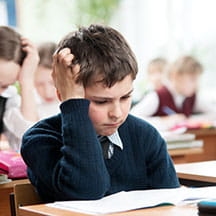Heather Huszti has vivid memories of March 2020—the meetings, the words and the concerns about an epidemic that was about to change life as everyone knew it. “When COVID first started, I can remember sitting in a leadership meeting with our team of mental health providers, and we were saying, ‘What’s going on here? Maybe we’re going to have to close down for a couple of weeks, and then we’ll be back—and everything will be as it was,’” says Huszti, chief psychologist at Children’s Health of Orange County (CHOC). “I went through the literature because lots of people were asking, ‘What’s the effect going to be on kids?’ Of course, there was no literature on something like this.”
The closest comparison Huszti could find was literature on the effects of severe acute respiratory syndrome (SARS) and H1N1 quarantines, as well as natural disasters. Even though the magnitude of the COVID-19 pandemic is much higher than those events, Huszti could see parallels between them. “Researchers who followed kids for many years after a disaster or traumatic event found increased depression and anxiety that continued for three to five years,” says Huszti. “Although those weren’t pandemics, we’re seeing it play out like the literature suggests.”
Huszti says it’s natural to want to leap to a post-COVID-19 world, and many signs make it seem like we’re there. Children and adolescents around the country have been back in the classroom for some time now, and signs of routine life have sprung. But the pandemic exacerbated a behavioral and mental health crisis among kids, and the crisis has only grown.
What the stats say
It may feel like life is inching toward normal, but data on kids’ and teens’ mental health continue to show negative trends. “Despite the return to in-person school, which many people felt would boost kids’ mental health, we’re not seeing declines in depression or suicide,” says Jami Young, Ph.D., associate chair of research at Children’s Hospital of Philadelphia, Department of Child and Adolescent Psychiatry and Behavioral Sciences.
Young says her team has been struck by the data, which show mental health concerns seem to be worse this year than they were last year. “Particularly as this pandemic moves forward, we’re continuing to see increased rates of depression, anxiety, suicide and eating disorder risk amongst our teens,” she says.
Huszti is seeing the stats jump in CHOC’s emergency department: visits for mental or behavioral health concerns increased 41% from July 2019 to March 2022 and visits for medically unstable children with eating disorders increased 94%. Huszti says CHOC’s outpatient mental health clinic is receiving about 200 referrals a month—a record high—and the age of suicide and suicide ideation is getting younger. “We’re seeing more mental and behavioral health concerns, and it’s more acute,” Huszti says. “Clinicians like myself who have been practicing for decades are saying they’ve never seen anything like this.’”
Despite a return to in-person school, we are not seeing declines in depression or suicide.
Young says school counselors are telling a similar story. “One of them said they had done more suicide assessments in this past year than in the last five years combined, and that they’re doing at least one, if not more, every day,” she says. “It’s important to recognize the role schools play in promoting access to school mental health services and recognize that kids need these services even more.”
These observations suggest that, while children’s hospitals were in crisis mode during the height of the pandemic, now is the time to shift to supporting longer term prevention, surveillance and community interventions. And schools continue to be an area of opportunity where children’s hospitals can build partnerships to achieve these aims.
The importance of community
Jill Haak Bohnenkamp believes in the power of community and low-cost, high-impact mental health promotion activities in the schools. She says even the smallest of gestures and moments can have a tremendous effect—like a bus driver or teacher who provides a student with a warm greeting, an administrator who is supportive, or a community event welcoming caregivers into the classroom to see what kids are learning.
“We need to make sure we’re doing things to support strong teacher-student-caregiver relationships,” says Bohnenkamp, Ph.D., assistant professor at the National Center for School Mental Health, Division of Child and Adolescent Psychiatry, University of Maryland School of Medicine. “We have not had as much of those things because of the pandemic, and they are critical pieces that build a student’s academic, social and emotional competencies.”
Recent CDC research shows that this kind of personal connectedness has lasting effects. Youth who feel connected with the community at school and the family at home are as much as 66% less likely to experience health risk behaviors related to sexual health, substance use, violence and mental health in adulthood.

The role of children’s hospitals
Children’s hospitals are looking for new ways to partner with schools to further advance children’s mental health care. “Both children’s hospitals and school systems are very interested in building their capacity,” says Bohnenkamp. For example, CHOC's population and mental health teams partnered with Orange County middle schools and high schools to create WellSpaces, places where kids can drop in and see a counselor during school hours. It is staffed by the schools, but it’s a collaboration between the system and CHOC to support kids when and where they need it. “It’s designed to help kids relax,” Huszti says. “It has activities that can help teach them healthy coping skills."
Even in the wake of this rise in mental health concerns, I feel optimistic seeing the national and local community’s support for children’s mental health.
To create or build on partnerships with school systems, Bohnenkamp suggests children’s hospitals start with a phone call. “Look for district-level leaders to connect with—this might be a director of student support services or director of school psychology—and have those conversations.”
Bohnenkamp recommends children’s hospitals build a Memorandum of Understanding with school systems, talking through what the school needs and what the children’s hospital can offer. She says these kinds of partnerships will go a long way in building a brighter tomorrow for the children and teens suffering today. “Even in the wake of this rise in mental health concerns, I feel optimistic seeing the national and local community’s support for children’s mental health,” says Bohnenkamp. “I’m heartened by that—and we have opportunities to transform the way we support youth and families.”



